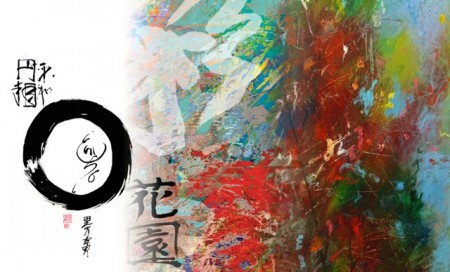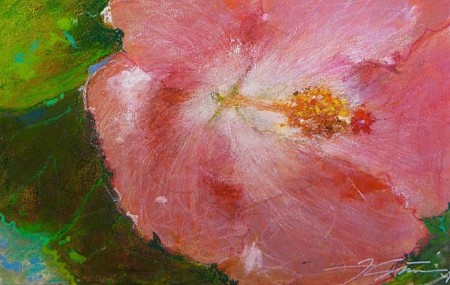Frank Satogata’s studio is deep in the Brazee Street complex of artists’ work spaces, down one hall and then another, up stairs and along another hall before a knock on a door brings this pleasant, smiling man to open it and a little flurry results as his companion Elle, a West Highland terrier, is equally hospitable to incoming guests.
Elle is small and white-furred and the studio walls are also white but the studio is alive with color from paintings leaning against walls, against tables, some of them hung, others wherever they can be conveniently propped. One wall, however, has no paintings at all on it. What it does have are straight rows of tool-type objects, carefully selected, in thoughtful shape relationships to one another, conferring art status to the means of making things, cleaning things, fixing things.
On the table just below is an antique typewriter, so old that its brand name, in gold letters against the black surface, is “Corona.” “Before it became ‘Smith-Corona,’” Satogata points out, adding “I love collecting.” His grandfather was a carpenter, he tells me, suggesting that his own interest in tools may stem from him. There’s a back scratcher (its handle can be compressed or lengthened at will), a Japanese saw (“the teeth cut the opposite way from an Occidental saw”), an odd, brush-like object that is a gathering of cake testers, slim inserts to see if the cake is done. Satogata’s pleasure in these interesting objects is an extension of an artist’s consuming desire to make visual sense of what he sees.
“The basis of my work is mark making, brush work is my identity,[the way I] define the object,” he says. Calligraphy, one form of mark making, he considers key to what he does. “The west uses a pen for calligraphy, the east a brush.” Artists Satogata identifies with are the Impressionists, J.M.W. Turner, the Abstract Expressionists “for their free brush work,” and color field artists. Both east and west, he points out, are in his work; “I’m still working toward a fusion of the two.” He’s studied non-eastern calligraphy (Arabic, Hebrew) as well as oriental versions.
Daniel Brown, frequent exhibition curator (and editor of this publication), says of the blend of influences in this artist’s work: “What we in the West call ‘the gesture,’ in abstraction – particularly abstract expressionism – in the East is the calligraphic. So Western abstraction, which uses the sweep of the hand and wrist, becomes appealing to Asian artists who use their entire arm to create that same sweep: that’s the hybrid in a nutshell, so that gesture/calligraphic become nearly one and the same. Satogata’s flowers seem to be the most gestural/calligraphic of all. I think that because of the speed with which he (and the best Asians) paint, it almost appears that the flowers are blooming/bursting into bloom right before our eyes, because he flips that ‘gesture’ into his sense of the calligraphic and then the flower with the variously colored backgrounds create the Western figure/ground relationships.”
The world Satogata shows us is devoid of people. There are color-shot landscapes, works focused on a single, large scale flower, others in which shape and color have become the only subjects needed. His prints, some on washi paper and some (large, 20 inches x 30 inches) on aluminum, are originally done in oil and have similar subject matter.
Color is key to much of Satogata’s work. He did not care for Jackson Pollock originally, he says, but has altered his opinion. Within the last ten years, he’s found that “Pollock seems arbitrary, but is not.” Pollock worked in layers, as does Satogata, taking advantage of the fact that “everything is a reaction to what came before. What’s around a color is vital.” Satogata uses acrylic paints; Pollock was an early user of synthetic enamels, then considered “household paints.”
Satogata also does striking calligraphic pieces, using a large brush for black ink on white paper, often large scale. These works have spawned a new venture into performance art, in which he works in front of an audience, a process that “expresses what I’m after and lets the viewers into my creative process.”
“There is no right or wrong” Satogata says about making art, and speaks of his unintended but telling error in having tee shirts made with one of his favorite expressions. The phrase, “Embrace Imperfection,” on the tee shirts appears without the ‘r’ in “imperfection.” Which seems, oddly, perfect.
Satogata, of Japanese ancestry, was born in Honolulu, Hawaii, where his mother (now in her nineties) still lives. His father, who also had been born in Hawaii, is no longer living but Satogata returns yearly to visit his mother. He has been to Japan itself only once, several years ago, with his mother and his aunt, both of whom speak fluent Japanese. He himself speaks it “a little.” In Hawaii, however, the population when he was growing up was fifty percent Japanese and has only increased in the years since.
Satogata came to Cincinnati in 1971, establishing a studio at Rookwood in Mt. Adams and working in graphic design. He produced catalogs for the Contemporary Arts Center and the first poster for the Aronoff Center, among other projects. Early on, the well-established Cincinnati artist Paul Chidlaw had a studio above Satogata’s and the young artist asked the older man to critique some of his work. To his great surprise, Chidlaw told him he needed to be older. “Now, that makes sense to me,” says the artist who has spent decades honing his skills, but apparently it took time to recognize.
Satogata has also has been an Adjunct Professor at both the University of Cincinnati’s Design, Architecture, Art and Planning school and the Art Academy of Cincinnati. His own art education took place in this country at the University of Oregon, the University of Minnesota and Syracuse University and in London, England, at the Heatherly School of Fine Art.
Among his Cincinnati design projects was working with Heather Hallenberg, then at the Taft Museum, on several of the institution’s catalogs. He and Hallenberg would later marry; she continues to be a figure in Cincinnati’s art world, on the staff of Arts Wave. Their son is now graduating from the University of Cincinnati. Satogata’s other son, from an earlier marriage, is a nuclear physicist in Virginia.
Satogata’s work frequently appears in exhibitions. Currently, he is in a two person show with Susan Mahan, whose work is nicely compatible with his, for the exhibition “Kaleidoscope: A Continually Changing Pattern of Shapes and Colors” at Art Access Gallery in Bexley, Ohio through March 20. A one-person show will open at Urbana College in Urbana, Ohio in March.
Satogata is an artist whose work continually evolves. “I never think ‘I got it!’,” he says, laughing. “The whole point of painting is exploring. It’s a process, not a product. Exploring, discovery are what’s going on.”
It’s always interesting to see what’s going on in Frank Satogata’s work. It’s frequently flat-out beautiful – to use a term seldom employed by the art-critical establishment. But beauty should never be dismissed.








